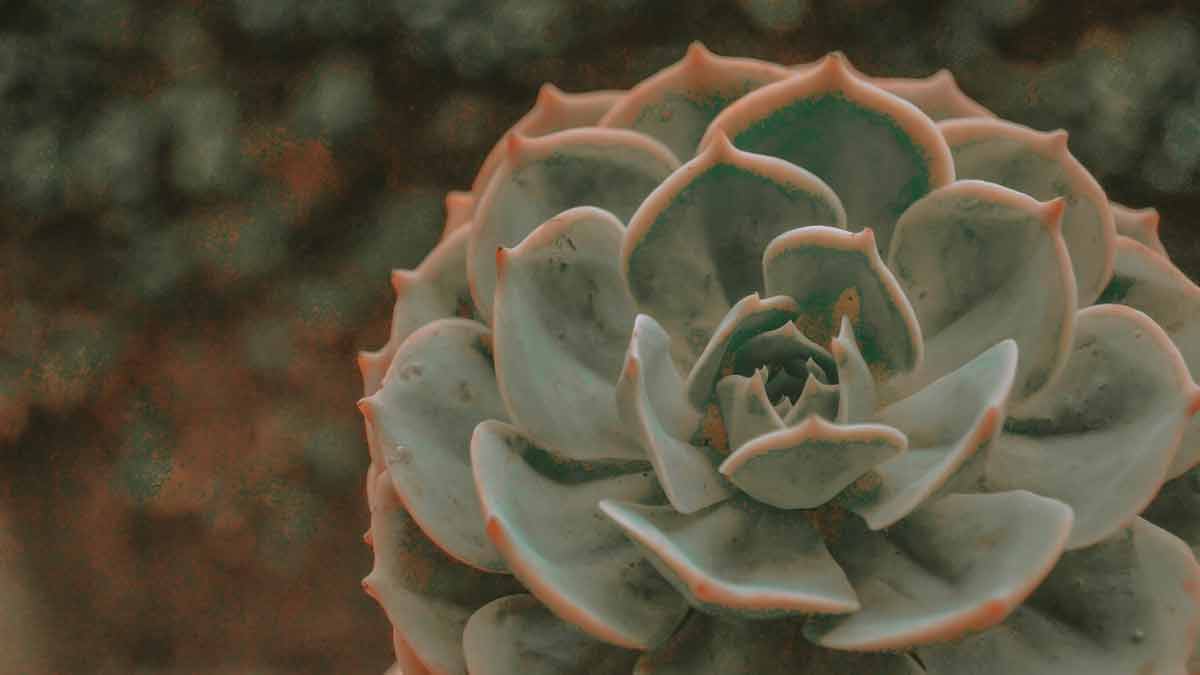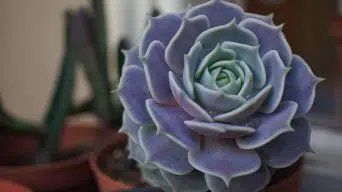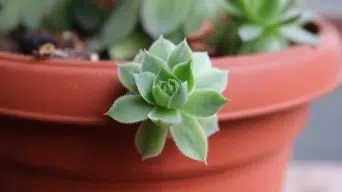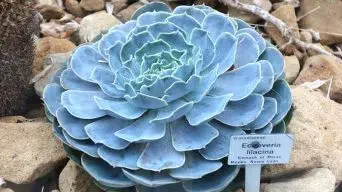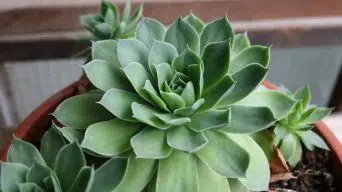Echeveria plants, known for their stunning rosette shapes and vibrant colors, are a must-have addition to any indoor or outdoor garden collection.
These low-maintenance succulents thrive in various environments, making them perfect for seasoned green thumbs and plant care beginners.
In this guide to growing and caring for echeveria plants, we’ll explore their origins, varieties, and best practices to help you cultivate an eye-catching display that leaves your guests in awe.
An Overview Of Echeveria Plants
The Echeveria plant, a native of Central and South America, is a popular succulent that boasts eye-catching rosettes formed by fleshy green leaves.
The origins of the name trace back to 18th-century Mexican artist Atanasio Echeverría y Godoy, who drew exceptional illustrations of Central American plants.
Echeverias come in varying shades of green – from light hues to deep jewel tones – often exhibiting plump or “juicy” characteristics in their growth habits.
These attractive plants have distinctive bell-shaped blossoms that add charm and elegance to any setting they inhabit.
Growth habits are typically moderate for these resilient plants; however, proper care and attention will impact your Echeveria’s overall health and vibrancy.
Echeveria Varieties
Echeveria plants boast a wide array of stunning varieties, each with its own unique appearance and care needs.
Some popular types of Echeveria that plant owners may want to consider include:
- Echeveria Peacockii: This variety adds elegance to any indoor or outdoor setting with its distinct blue-gray leaves and rosette shape.
- Echeveria ‘Black Prince’: This hardy Echeveria features dark purple-black leaves that form a tight rosette and produce striking red flowers in the fall.
- Echeveria Lilacina ‘Ghost Echeveria’: Known for its powdery white-blue leaves, this eye-catching variety boasts a rosette shape that spans up to 6 inches in diameter.
- Echeveria ‘Lola’: A hybrid variety with delicate lilac-colored leaves, it forms a compact rosette perfect for small spaces or container gardens.
- Echeveria ‘Perle von Nürnberg’: This popular cultivar features grayish-purple leaves with pink highlights and produces vibrant coral-pink flowers in summer.
- Echeveria Runyonii ‘Topsy Turvy’: With its unusual twisted and curving leaves, this intriguing variety adds a unique touch to any collection of succulents.
With over 100 species and hybrids available, finding the perfect Echeveria variety for your home or garden is an exciting adventure.
Remember that sunlight requirements and other care necessities may vary slightly between types, so be sure to research the specific needs of your chosen plants for optimal growth and health.
Caring For Echeveria Succulents
Ensuring optimal care is essential to unlock the full potential of these resilient plants, allowing them to thrive and showcase their breathtaking array of colors and captivating shapes.
The following guidelines provide valuable insights into nurturing your Echeveria succulents for vibrant and healthy growth.
Sunlight Requirements And Placement
Echeveria plants thrive in bright light, making sunlight requirements and placement crucial to their care.
These stunning succulents need anywhere from 4 to 6 hours of direct sunlight per day for optimal growth, so be sure to place them near a west-facing or east-facing window if you’re growing them indoors.
It’s also important to note that Echeverias naturally grow towards the light source.
To maintain an even rosette shape and avoid leggy growth, make it a habit to rotate your plant every few weeks so all sides receive equal exposure.
Watering Needs And Schedule
Echeveria plants are drought-resistant succulents, which means they have low watering needs.
Excessive watering is a prevalent error that may result in root rot and the eventual demise of the plant.
It is important to check if the soil has completely dried out before watering your Echeveria plant again.
Depending on the pot size and weather conditions, it’s best to water these plants once every week or ten days in summer and less frequently in winter.
Watering from below using a saucer prevents waterlogging around the roots while ensuring the soil remains slightly moist.
To establish a healthy watering routine for your Echeverias, take note of their response after each watering session- whether they look plump and perky or wrinkly and soft suggests proper hydration levels for future reference.
Soil Requirements And Composition
The soil composition is a vital aspect of caring for your echeveria plants. These succulents require well-draining soil that will dry out quickly to prevent root rot and other issues.
A combination of coarse sand, succulent potting mix, and perlite is perfect for growing Echeveria as it allows proper drainage while retaining enough moisture.
Growing Echeveria in an unglazed clay pot is ideal as it allows water to evaporate quickly from the sides, preventing standing water at the bottom that could lead to root rot.
Keeping an eye on your soil composition is crucial in caring for echeveria plants and ensuring their overall health and growth.
Optimal Temperature And Humidity Levels
Echeveria succulents are known for their hardiness and ability to thrive in hot and dry conditions.
However, they do have specific temperature requirements that must be met for optimal growth.
Ideally, these plants should be kept in environments with temperatures ranging between 65-70°F.
Regarding humidity levels, avoiding exposing Echeveria plants to excessive moisture is crucial, as too much humidity can lead to root rot and other issues.
These succulents prefer drier air, so it’s recommended to maintain a moderate humidity level indoors by using a dehumidifier or placing bowls filled with water near the plant (without letting the water come into direct contact).
Fertilizing And Nutrient Requirements
Echeverias are not heavy feeders, and they do not require regular fertilizing.
These succulents are used to thrive in nutrient-poor soil, so adding too much fertilizer can harm them.
However, if you want to boost your Echeveria, a cactus or succulent liquid fertilizer can help.
When applying fertilizers, be careful not to overdo it, as excess nutrients can cause problems like root rot or fertilizer burn.
Always follow the instructions on the package carefully and use sparingly.
Remember that these plants have evolved in harsh conditions with low nutrient availability, so even a tiny amount of fertilizer promotes healthy growth and vibrant foliage.
Potting And Repotting Considerations
Knowing the proper potting and repotting guidelines is essential to ensure your Echeveria plant thrives.
Here are some key considerations to keep in mind:
- Only repot your Echeveria when it has outgrown its current container or if you notice the soil is not draining well.
- When choosing a new pot, ensure it has drainage holes to prevent overwatering and root rot.
- Use a specific “Cactus & Succulent” compost that has excellent drainage and allows for proper root growth.
- Fill the new pot with enough soil so that the rosette base is level with the top of the pot.
- Water your newly potted Echeveria sparingly for a few days until it fully adjusts to its new environment.
- After repotting, provide plenty of bright, indirect light to help your Echeveria establish new roots and grow healthy foliage.
Pruning And Maintenance
Pruning and maintaining Echeveria plants are essential for their growth and overall health.
Here are some tips to keep your Echeveria succulents in tip-top shape:
- Remove dead leaves and flowers regularly. This will prevent the spread of disease, pests, and fungi.
- Cut out any leggy growth that may occur, as it can indicate a lack of sufficient light or over-fertilization.
- Prune for optimal results at the beginning of their growing season (spring to summer).
- Use clean tools to avoid spreading infection or disease when pruning.
- If propagating Echeveria using stem cuttings, pruning the mother plant can stimulate new growth.
- Consider repotting your Echeveria plants if they outgrow their container or become root-bound.
- Avoid touching the leaves too much, as this can cause them to bruise and damage.
- Use a well-draining soil mix with coarse sand or perlite for proper drainage and nutrient absorption.
Troubleshooting Common Echeveria Plant Problems
If you’re having trouble with your Echeveria succulents, don’t worry!
In this section, we’ll cover common problems like root rot and pests and provide tips on how to keep your plants thriving.
Overwatering And Underwatering
Proper watering is one of the most crucial aspects of caring for Echeveria succulents.
Excessive watering is a prevalent error that may result in root rot, whereas insufficient watering can lead to wilting and hindered growth.
To avoid overwatering, ensure your Echeveria plants are in fast-draining soil, allowing excess water to escape quickly.
Wait until the top 1-2 inches of soil are completely dry before watering again, which may take a few days to a week, depending on factors such as temperature and humidity levels.
On the other hand, if you notice signs of dehydration, such as sagging leaves or dry soil, it’s time to give your plant a good soak until water comes out through the drainage holes at the bottom of its container.
Pest And Disease
Echeveria plants are generally hardy and resistant to pests and disease but can sometimes be affected.
To keep your Echeveria succulents healthy, watch out for the following:
- Fungus Gnats: These are commonly attracted to damp soil conditions that can lead to root rot in Echeveria plants. You can control fungus gnats by letting the soil dry out between watering.
- Spider Mites: These tiny pests can cause yellowing leaves and webbing on plant foliage. If you notice spider mites, wipe the leaves with a damp cloth or use insecticidal soap.
- Mealybugs: These white, cottony insects can damage echeveria leaves and cause stunted growth. Remove them manually with a brush dipped in alcohol or use neem oil spray as an insecticide.
- Powdery Mildew: This fungal disease causes white powdery patches on the succulent’s leaves and stems. It is usually caused by humid air, so ensure good ventilation and avoid getting water on the plant when misting.
- Fertilizer Burn: Applying too much fertilizer can burn the succulent’s roots and cause wilting and brown tips on its leaves. Do not over-fertilize your echeveria plants; follow label instructions carefully.
Sunburn And Heat Stress
Echeveria plants are susceptible to sunburn and heat stress, particularly in hot climates.
Sunburn can appear as white or pale patches on the plant leaves, causing damage that cannot be reversed.
To prevent sunburn, it is important to expose Echeveria plants to more direct sunlight over time gradually.
Too much exposure too quickly can cause irreparable harm.
Heat stress occurs when temperatures rise above what the plant is accustomed to handling, which may result in the leaves wilting or turning brown at their tips.
Propagating Echeveria Succulents
Expanding your plant collection can be an easy and fulfilling experience by propagating echeveria succulent plants.
Leaf And Stem Propagation Methods
Echeveria succulent plants can be propagated through different methods.
Here are the steps for leaf and stem propagation methods:
1. Leaf Propagation Method
- Choose a healthy leaf from the Echeveria plant.
- Let the leaf dry out for a few days until it forms a callus at the end.
- Plant the callused end of the leaf into well-draining soil, with about half of the leaf buried in the soil.
- Water sparingly, allowing the soil to dry out between watering.
- Within several weeks, new roots should start to grow, and a new plantlet will sprout from the base of the original leaf.
2. Stem Propagation Method:
- Cut a stem section from the parent Echeveria plant using sharp, sterilized scissors or pruning shears.
- Let it dry out for 1 – 2 days until it forms a callus on both ends.
- Plant it in well-draining soil in a pot with drainage holes.
- Water sparingly to avoid overwatering and root rot until roots form and new growth appears.
Using honey or rooting hormone powder can help speed up root development in both methods.
When propagating echeveria succulents, keep them in bright indirect light for optimal growth.
Tips For Successful Propagation
Propagation is an essential part of growing echeverias, and there are a few tips to help ensure success.
Firstly, using a well-draining soil mix that will not hold excess water is important, as this can cause root rot.
A coarse sand or perlite mixed with potting soil is a good option. Secondly, when propagating by leaf cuttings, use only healthy leaves with no damage or pest infestations.
Thirdly, occasionally place the cutting in bright but indirect light and mist until roots form.
Another great way to propagate echeverias is by gently separating the offsets (or babies) around the parent plant’s base.
These baby plants already have their root system and can grow independently with proper care routines like the original plant.
Following these tips for successful propagation, patience, and TLC, you’ll soon have multiple healthy echeveria plants thriving in your garden or home collection!
Care And Maintenance Of New Plants
After successfully propagating your Echeveria succulent, it is important to provide proper care and maintenance for the new plant.
Here are some tips:
- Transfer the plantlet into a small pot with a well-draining soil mix.
- Water sparingly and wait until the soil dries out before watering again.
- Place the plant in an area with bright, indirect sunlight to promote healthy growth.
- Avoid exposing newly propagated plants to direct sunlight or extreme temperatures.
- Continue to monitor for pests and signs of overwatering, such as yellowing leaves or mushy stems.
- Do not fertilize newly propagated plants until they have established themselves in their new pot for at least 2-3 months.
- Keep an eye on the roots and consider repotting if they become overcrowded or begin to grow out of the drainage hole.
By following these care and maintenance tips, you can ensure that your newly propagated Echeveria succulent will thrive and continue to beautify your home or garden for years to come.
Displaying Echeveria Succulents
Enhance the aesthetics of your echeveria succulents by selecting the appropriate pot, complementing them with companion plants, and exploring innovative display concepts.
Choosing The Right Pot And Placement
Selecting the perfect pot and placing your Echeveria in the right location will help ensure a healthy, thriving plant.
When it comes to pots, choosing one with drainage holes is essential, as succulents like Echeverias prefer well-draining soil.
Some great options include clay or terra cotta pots, which are porous and allow excess moisture to evaporate from the soil.
As for placement, Echeverias need plenty of sunlight to thrive but should be protected from direct sun during the hottest part of the day to prevent sunburn.
Ideally placed near south or west-facing windows if grown indoors is best since they’ll receive plenty of light throughout the day without scorching their delicate leaves.
Companion Plant Pairings
Pairing your Echeveria plants with other succulents or ornamental plants can enhance the aesthetic appeal of your garden or indoor space.
When choosing companion plants, consider their shape, texture, and growth habits to create a visually pleasing arrangement.
Here are some examples of companion plants that pair well with Echeveria:
- Aeonium – With its tall, upward-growing rosettes, Aeonium can create a stunning contrast when placed beside low-growing Echeveria.
- Sedum – These low-maintenance succulents come in various shapes and textures that complement the fleshy leaves of Echeveria.
- Agave – The spiky leaves and architectural form make them an interesting addition to any succulent arrangement.
- Adenium – Also known as desert rose, these flowering succulents produce large blooms that add color and visual interest to your display.
- Lithops – These small, stone-like succulents are perfect for adding textural interest to your display and can be planted alongside Echeveria for a unique effect.
Remember to consider each plant’s growing conditions when selecting companions for Echeveria.
For example, all the above plants grow best in well-draining soil and require plenty of sunlight.
Adding companion plants is easy to elevate your Echeveria collection’s beauty and impact while creating a visually appealing indoor or outdoor garden display.
Creative Display Ideas
If you want to showcase your beautiful Echeveria succulents, there are plenty of creative ways to display these stunning plants.
Here are some ideas:
- Create a colorful arrangement by planting several varieties of Echeveria in a large, shallow dish or planter.
- Display your Echeveria in a hanging planter for an eye-catching display that allows the rosettes to cascade down.
- Use unique containers like teacups or vintage glassware to add charm and personality to your Echeveria display.
- Combine Echeveria with other succulent varieties and cacti for a striking desert landscape effect.
- Fill open terrariums or glass globes with various types of Echeveria for a modern and stylish look.
- Create vertical gardens by planting Echeveria on walls or trellises using wire mesh or other supports.
- Mix and match different colored varieties of Echeveria for an eclectic and playful display.
No matter how you display your Echeveria plants, keep them well cared for using the tips in this ultimate guide so they can continue to thrive and add beauty to your space!
Final Thoughts
Growing and caring for Echeveria plants can be a rewarding and fulfilling experience for both new and experienced plant owners.
Remember to provide them with well-draining soil, adequate sunlight, and proper watering to maintain their beauty.
With the proper care and attention, these hardy succulents will thrive in your home or garden.
Don’t forget to propagate them with leaf cuttings, display them creatively, and watch as they add a touch of natural elegance to any space.

